Black Tupelo Tree: Leaves, Bark (Pictures) – Identification and Care Guide

The black tupelo tree is an attractive ornamental tree native to North America. Also called the black gum or sour gum, the deciduous tree is identified by its oval, dark green glossy leaves, bark resembling alligator skin, clusters of greenish-white flowers, and bluish-black fruits. The spectacular feature of black tupelo trees is its eye-catching fall foliage, which can turn vibrant orange, bright red, yellow, or purple shades.
This article is a complete guide to the majestic black tupelo tree. Descriptions and pictures of the tree’s identifying characteristics will help recognize this tree in landscapes. You will also get helpful tips on growing a black tupelo landscape tree in your front or backyard.
About Black Tupelo Tree (Nyssa sylvatica)
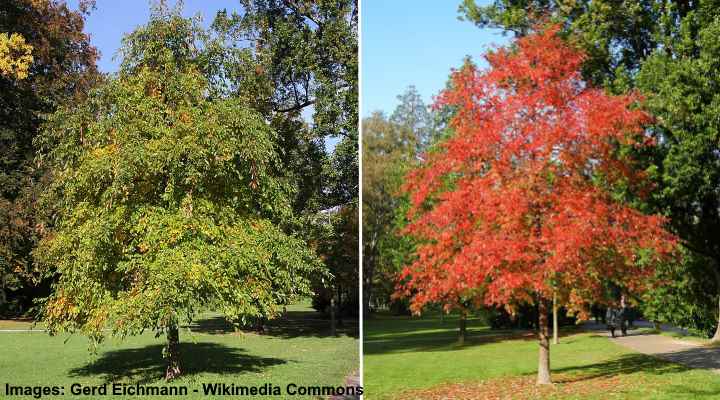
Black tupelo tree (Nyssa sylvatica) is an ornamental deciduous tree that has beautiful fall colors
The black tupelo tree (Nyssa sylvatica) is a medium-sized flowering tree in the plant family Nyssaceae. A black tupelo tree has a broadly conical habit with branches spreading horizontally from the main trunk. The dense, glossy green foliage, pyramidal shape, inconspicuous flowers, and dark-colored edible fruits make the black tupelo easily recognizable.
The black tupelo tree is classed as a medium-sized deciduous tree with moderate growth, growing about 12” (30 cm) per year. The ornamental tree grows between 50 and 80 ft. (15 – 24 m) in ideal conditions. However, the average black tupelo’s height in residential settings is 30 to 50 ft. (10 – 15 m).
As an attractive landscape tree for temperate climates, the black tupelo is suitable for planting in USDA zones 4 through 9. The growing conditions are full sun, evenly moist, well-drained soils, and shelter from cold winds.
The black tupelo isn’t classed as a messy tree. Although it produces juicy dark-blue to black berries, birds typically consume them all before they drop to the ground. However, there may be some cleanup if the drupes fall on driveways or sidewalks.
Additionally, the branching structure is relatively robust, and black tupelo trees don’t lose twigs and small branches easily. Also, black tupelo flowers don’t make a mess when they fall.
The most common use for black tupelo trees is an ornamental shade or specimen tree in parks and extensive gardens. This beautiful tree, with its conical shape, looks very attractive. However, the tree becomes one of the most breathtaking trees in a fall landscape.
The black tupelo is classed among the “brilliant group” of colorful fall trees. Many people rate the fiery reds, oranges, and yellows of the black tupelo as more spectacular than maples, sweet gum trees, dogwoods, and sassafras.
Black tupelo trees also go by the names black gum tree, sour gum tree, and Nyssa pepperidge. Despite its common name of black gum, the tree doesn’t have the “gummy” resin typical of the sweet gum tree. In addition, the black gum tree doesn’t have the spiny balls characteristic of the unrelated sweet gum tree.
The botanical name for the black tupelo — Nyssa sylvatica — refers to its tendency to grow near water. Nyssa is a mythological water nymph. So, you will often find the black gum trees growing near streams and swamps.
Black Tupelo Tree Leaves
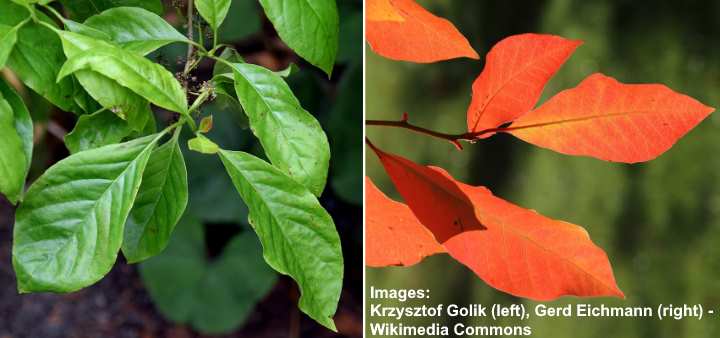
Black tupelo leaves
Leaves on the black tupelo tree are oblong with a pointed tip, dark, glossy green color, and leathery feel. The oval or elliptical-shaped leaves grow 2” to 5” (2.5 – 13 cm) long and up to 3” (7.5 cm) broad. The simple, thick, dark green leaves grow alternately on twigs.
In the fall, black tupelo leaves turn vibrant red and become reddish-purple as the season progresses. Other colors of black tupelo leaves are golden yellow, warm orange and purple. The fall foliage of black tupelo makes the tree easy to identify in an autumn landscape.
It’s not just its fall colors that make the black tupelo a welcome addition to a landscape. The leathery green pointed leaves with their shiny coating create lush green colors and provide shade from the summer sun.
Black Tupelo Tree Flowers
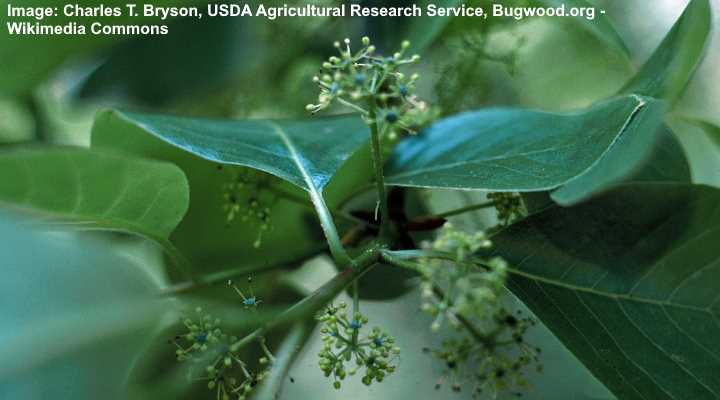
Black tupelo flowers
Flowers on the black tupelo tree bloom in spring and are small clusters of greenish white flowers. The inconspicuous flowers grow in small conical clusters called umbels. Unfortunately, the flowers are difficult to recognize between the shiny green leaves.
Black tupelo flowers are prized for their nectar, which attracts pollinators and honeybees. When combined with the several other species of tupelo, black tupelo honey is popular with honey producers. Honey from black tupelo trees has a light and mild taste and fetches a high price.
Black Tupelo Tree Bark
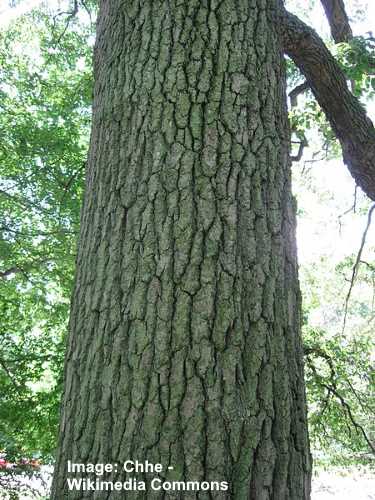
Bark on mature black tupelo tree
Black tupelo bark is smooth and reddish-brown on immature trees. The bark develops deep furrows and a scaly appearance with a distinctive pattern as the tree matures. An identifying feature of the black tupelo is its medium-gray to reddish bark that looks like alligator hide.
The colorful reddish twigs and stems are another identifying characteristic of black tupelo trees. The thin twigs are a reddish-brown color and develop grayish skin. In addition, the leaf branches contain a red pigment that adds to the tree’s fall foliage color.
Black Tupelo Tree Fruit
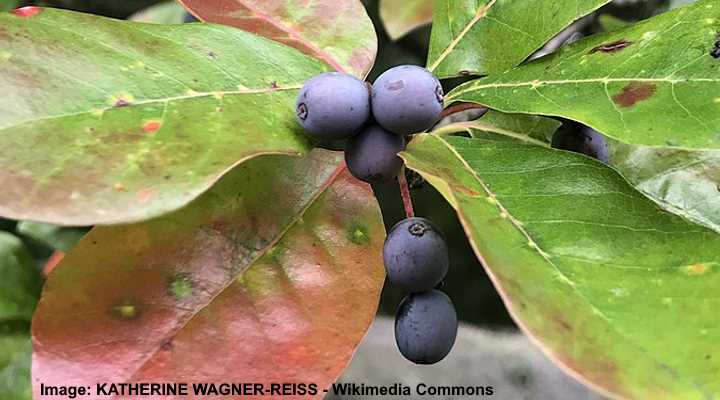
Black tupelo fruit
The fruit on a black tupelo tree is a small bluish-purple berry-like drupe. Each small, round dark purple fruit contains a single stone surrounded by sour-tasting flesh. The dark egg-shaped drupes measure 0.4” (10 mm) long and grow in groups of one to three berries on slender red stalks.
Black tupelo fruits are edible, but they have a sour taste. You can use black tupelo drupe to make preserves, jellies, jams, juice, or use them in baking. The sour-tasting black fruits are popular with birds and other wildlife.
Black Tupelo Tree Identification
A black tupelo tree is identified by its straight trunk with gray bark resembling alligator skin, a conical crown, leathery green leaves, clusters of small black oval fruits, and inconspicuous flowers. In the fall, it’s easy to recognize black tupelo due to its vibrant red leaves that cover the spreading branches.
Where to Plant Black Tupelo Tree
The black tupelo tree thrives in full sun or partial shade. The best location to plant a tree is deep, acidic soil that stays evenly moist. Although damp ground is ideal for growing black tupelo, the tree tolerates occasional drought. Because they have a large taproot, the planting location must have deep soil.
It is vital to think carefully about where to plant a black tupelo tree. Once established in the ground, the deep taproot makes it difficult to transplant without damaging it. So, ensure the mature tree’s size won’t interfere with building foundations, power lines, or other structures. Also, because you can expect some fruit to fall, it’s best to plant away from paths or sidewalks.
Black tupelo trees have some specific requirements where they are planted. For example, the trees don’t tend to grow well in alkaline soil and usually die young. In addition, urban pollution in the air or soil stresses the tree, and it won’t thrive.
How to Plant Black Tupelo Tree
When planting a black tupelo tree, dig a hole large enough to accommodate the deep roots. Next, prepare the soil by mixing a good amount of compost to increase acidity. When the hole is ready, plant the tree level with the surrounding soil and backfill with the amended acidic soil.
As you add soil to the hole, keep pressing it down to remove any air pockets. Next, water the black tupelo thoroughly and stake it to prevent strong winds from harming it. Then add 1” to 3” (2.5 – 7.5 cm) organic mulch to help lock in moisture and prevent weeds from growing. Just remember to leave 6” (15 cm) diameter around the trunk free from mulch.
Black Tupelo Tree Landscape Uses
In a garden landscape, a black tupelo tree grows around 20 to 30 ft. (6 – 9 m). Because the tree tolerates wet, well-drained soils, it is an excellent choice for low landscape areas. However, the black tupelo won’t perform well in heavily shaded gardens or alkaline soil.
The black tupelo performs best in rural areas without pollution. The attractive pyramidal shape of the tree looks stunning as a single specimen, shade tree, or in small groups. However, it’s best to keep the trees away from driveways or sidewalks as they may cause some mess if many fruits fall.
Black Tupelo Tree Care Guide
Black tupelo trees have minimal care needs when established in the landscape. The flowering ornamental trees tolerate wet soil and some spells of dry weather. In addition, the trees don’t require much pruning to develop a robust branching system. And they are relatively resistant to pests and diseases.
Here are some handy tips on caring for a black tupelo tree.
How to Water Black Tupelo Tree
A black tupelo tree thrives in moist soil, and you should water it regularly, especially when it’s young. The best foliage grows on the trees when the soil is kept evenly moist. Therefore, it is necessary to water the tree thoroughly if there is a prolonged period without rainfall.
To water black tupelo, soak the soil twice a week when the tree is young. To do this, use a sprinkler system and water for 45 minutes each time. To water an established black tupelo tree, water only during dry periods, and you can run the sprinkler for 45 minutes once a week.
However, black tupelo trees have some drought tolerance. This means that mature trees can adapt to growing in relatively dry soils. On the other hand, the black gum tree will also tolerate poorly-drained soils and even doesn’t mind growing in standing water.
How to Fertilize a Black Tupelo Tree
A black tupelo tree benefits from fertilizing once a year in the fall. Use a slow-release granular fertilizer for trees. How much fertilizer should you use for a black gum tree? First, measure the trunk’s diameter about 4 ft. (1.2 m) above the ground. Then measure 2 cups of fertilizer for every 1 inch of trunk diameter.
To fertilize the ground, evenly spread the granules on the soil, starting at the trunk and extending it 1.5 times the distance from the trunk to the end of branch tips. Then thoroughly water the ground to allow the fertilizer to absorb into the soil.
Pruning Black Tupelo Tree
The black tupelo tree has minimal pruning requirements, and you only need to prune dead or diseased branches in late fall or winter. You can also prune weaker branches or any branches drooping downward to improve the tree’s shape. Although the dormant season is the best time to prune, you can remove damaged branches at any time.
Black Tupelo Tree Propagation
The easiest way to propagate a black tupelo tree is by seed. Typically, cuttings from black tupelos are problematic to root and often fail to grow. However, seeds require a period of stratification or planting immediately after collection for seeds to germinate.
After harvesting seeds from the black tupelo drupes, you should put them in a moist medium in a plastic bag and then in the refrigerator for 30 to 60 days. Then transfer the seeds to a damp potting medium and place them in partial shade. Cover with plastic and keep moist until seedlings appear. Finally, you can transfer the seedlings to the ground the following spring.
Pests Affecting Black Tupelo Tree Growth
Black tupelo trees are typically resistant to bugs and pests if they grow in moist soil and get plenty of sunlight. This is because the tree’s thick leathery leaves tend to deter common tree pests like aphids, caterpillars, and other sap-sucking insects from doing damage.
Pests affecting black tupelo include black twig borers, tupelo leaf miners, and scale insects.
Tupelo leaf miner moth (Antispila nysaefoliella): The larvae of this small black moth mine the leaves of black tupelo trees, causing the lush foliage to develop unsightly brown blotches and holes. In time the brown marks extend along the width of the leaf between the leaf veins. Larvae are active during August and September.
Related reading: How to get rid of leaf miners.
Black twig borer (Xylosandrus compactus): The small black beetles attack healthy trees, including black tupelo trees. The beetles bury into twigs and deposit eggs. The hatched larvae feed on the softwood inside the twig, causing it to become hollow. This results in wilted twigs and branches
Scale insects look like bumpy growths on black tupelo twigs and branches. The sap-sucking insects are difficult to spot because they stay in one spot. Find out here how to kill scale bugs.
Diseases Affecting Black Tupelo Tree Growth
Black tupelo trees are relatively resistant to disease because they thrive in damp soil and rarely succumb to root rot as quickly as other ornamental trees. However, certain foliar diseases caused by fungal infections can cause black tupelo leaves to turn yellow, curl up, and even die.
Verticillium wilt is a soil fungal disease that affects the root system of trees, including the black tupelo. As the disease progresses, it can cause leaves to become yellow or stunted and result in premature drop. If you notice signs of verticillium wilt, remove all infected branches and foliage and destroy.
Phytophthora can affect black tupelo trees because fungus-like organisms thrive in wet soils. The disease can cause the leaves to wilt and show signs of water stress. Eventually, it can lead to root rot or crown rot. If you notice signs of phytophthora, it’s best to improve drainage and let the roots dry. You may need to remove any mulch from the root area.
Fusarium wilt is similar to verticillium wilt and will cause leaves to turn yellow, shrivel up, and die. A severe infection can cause branch dieback that eventually kills a once healthy tree. The best way to keep a tree healthy is to remove all dead wood and foliage.
Related articles:
- Sourwood Tree – Identification Guide
- Smoke Tree: Complete Care Guide
- Purple Leaf Plum Trees: Types & Identification
